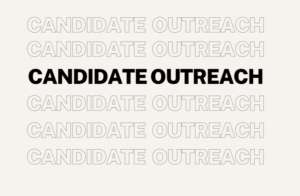
“How often should I message a passive candidate?” is a question frequently asked in the recruiting industry. Talent sourcers are responsible for sourcing external leads, which often involves reaching out to passive candidates who may not be actively seeking new opportunities. However, there is a fine line between effective outreach and spamming candidates.
To ensure that your outreach efforts are effective, it’s important to track the performance of your messages. Consider using a tool to track email opens, clicks, and responses to gauge how your messages are being received. If you notice low engagement rates, it may be an indication that your messaging is coming off as spammy or impersonal.
In this post, I will delve into this topic in more detail to provide additional guidance on how to effectively message passive candidates.
Defining what a Passive Candidate is:
A passive candidate is someone who is currently employed and not actively seeking a new job opportunity, but who may be open to considering new opportunities if the right offer comes along. Passive candidates are often highly skilled and experienced professionals who are valued in their current roles, but who may be open to new challenges or career advancement opportunities.
Recruiters often target passive candidates in their search for top talent, as they can offer valuable skills and expertise to an organization. However, reaching and engaging with passive candidates can be challenging, as they may not be actively looking for new opportunities and may not be as responsive to traditional recruiting methods.
Recruiters may use a variety of strategies to reach passive candidates, such as targeted messaging through social media, networking events, or personal referrals. The key is to provide a compelling reason for the passive candidate to consider the opportunity, such as highlighting the potential for career growth, challenging projects, or a competitive compensation package.
Passive Candidates:
When it comes to recruiting passive candidates, it’s important to strike a balance between persistence and being respectful of their time and boundaries. There’s no hard and fast rule for how many times you should message a passive candidate, as it will depend on a variety of factors such as the candidate’s level of interest, their preferred communication method, and your relationship with them.
However, as a general guideline, you may want to consider the following:
Make sure your initial message is clear and engaging, highlighting why you think the candidate would be a good fit for the position and your company.
Follow up with a second message a week or so after your initial message, acknowledging that you understand they may be busy but reiterating your interest in speaking with them.
If you still haven’t heard back after the second message, you can consider sending one or two more follow-up messages spaced out over a few weeks. However, it’s important to be respectful of the candidate’s time and not become overly persistent or pushy.
If you still haven’t received a response after several attempts, it may be best to assume that the candidate is not interested or unavailable at this time and move on to other potential candidates.
Follow the 80/20 Principle:
The 80/20 rule, also known as the Pareto principle, states that roughly 80% of the effects come from 20% of the causes. In the context of recruiting and messaging leads online, this principle suggests that 80% of your results will come from 20% of your efforts.
For recruiters, this means that a small number of your outreach efforts are likely to yield the majority of your results. By focusing on the most promising leads and channels for outreach, recruiters can maximize their efficiency and productivity.
In practice, the 80/20 rule can be applied to messaging leads online by prioritizing the most promising leads and focusing your messaging efforts on them. This might mean identifying key job boards or social media channels where your target candidates are most active, and tailoring your messaging to those platforms. It might also mean prioritizing candidates who have expressed interest or responded positively to your initial outreach, rather than continuing to pursue candidates who are unresponsive or uninterested.
By focusing on the most promising leads and channels for outreach, recruiters can improve their messaging efficiency and increase the likelihood of success in their recruiting efforts. However, it is important to remember that the 80/20 rule is a guideline and should not be taken as a strict rule. Every recruitment effort is unique and requires a tailored approach based on the specific needs and characteristics of the candidate pool and job market.
Follow these Steps when Crafting a Recruiter Message:
Start with a personalized greeting: Address the candidate by name and use a friendly and professional tone.
Introduce yourself and your organization: Provide a brief introduction to yourself and your organization, including what you do and what your organization stands for.
Highlight the opportunity: Explain why you are reaching out and what opportunity you have in mind. Be specific and mention what attracted you to the candidate’s profile.
Emphasize the benefits: Highlight the benefits of the opportunity, including any potential career growth, exciting projects, or competitive compensation.
Keep it concise: Be clear and concise in your messaging. Avoid long paragraphs and make your points in a clear and direct manner.
Include a clear call-to-action: End your message with a clear call-to-action, such as asking the candidate to schedule a call or respond to the message if they are interested.
Personalize the message: Customize the message to the candidate’s background, skills, and experience. Mention specific accomplishments or skills that caught your attention.
Respect their time: Be respectful of the candidate’s time and avoid being overly pushy or aggressive in your messaging. Provide them with space to consider the opportunity and respond at their own pace.
CAN-SPAM ACT Guidelines:
The CAN-SPAM Act is a law that sets rules for commercial email messages and gives recipients the right to opt-out of receiving those messages. The Act requires businesses to include certain information in their emails, such as a valid physical postal address and a clear and conspicuous opt-out mechanism. It also prohibits misleading or deceptive subject lines and requires that emails be identified as advertisements.
Recruiters should follow the CAN-SPAM Act because it not only protects the privacy and preferences of potential candidates, but also helps to maintain the reputation of the recruiter and their organization. By following the rules outlined in the Act, recruiters can ensure that their messages are well-received and not marked as spam or blocked by email providers.
In addition, the Act carries significant penalties for non-compliance, including fines and legal action, which can be costly and damaging to a recruiter’s reputation. Therefore, it is important for recruiters to understand and follow the guidelines set out in the CAN-SPAM Act to ensure that their outreach efforts are effective and ethical.
What you Shouldn’t Do?
- Avoid requesting a CV from the candidate initially as a skilled sourcer can locate their information online.
- Avoid using buzzwords that may come across as generic and insincere.
- Refrain from copying and pasting the job requirements in your message to the candidate.
- Avoid being overly pushy in your outreach efforts.
- Before sending any messages or emails, ensure that they have been thoroughly proofread and spell-checked.
How many times should I message a Passive Candidate?
In my book, “Art of the Recruiter Message,” I recommend a method for messaging passive candidates that typically involves reaching out 4-6 times using various channels such as social media, email, inmail, or text. However, I have found that my sweet spot is around 3-4 outreaches before receiving a response.
If you’re not hearing anything back, I suggest experimenting more with personalizing your templates. It’s crucial to make your messages stand out and show that you have taken the time to understand the candidate’s background and skills.
Receiving a response that says “no thank you” is a positive sign that your messages are being reviewed. Most people only spend 20-30 seconds reading an email, so it’s essential to make a good impression quickly.
Pro Tip: If a candidate responds back with a “no,” it’s still worth taking the time to consider their potential interest in the future. This presents an opportunity to follow up and inquire if they might know someone else who could be a good fit for a role in that specific niche field.
Tracking and analyzing your email campaigns can help ensure that your messaging is on point and that you are not spamming candidates who are not interested or unqualified.
In conclusion, it’s important to do your research and take your time when it comes to messaging passive candidates. By following these guidelines, you can increase the chances of a positive response and ultimately, successfully recruit top talent for your organization.
Final Thoughts…
To ensure effective outreach to passive leads, it’s crucial to avoid spamming them. By following the methods I’ve outlined in this post, you can significantly improve your response rates and attract more interested candidates in a shorter amount of time.
Recommended Reading:
How to influence and persuade a Hiring Manager
Creative ways to find talent sourcing jobs in a tough economy
How to prioritize recruiting reqs
- AI Search Will Transform Talent Sourcing Forever - January 10, 2025
- Build an AI Sourcing Assistant using ChatGPT 4 - January 10, 2025
- Top Recruiting Leaders to Follow in 2025 - January 8, 2025

1 Comment on “Passive candidate outreach: How many times should I follow up?”